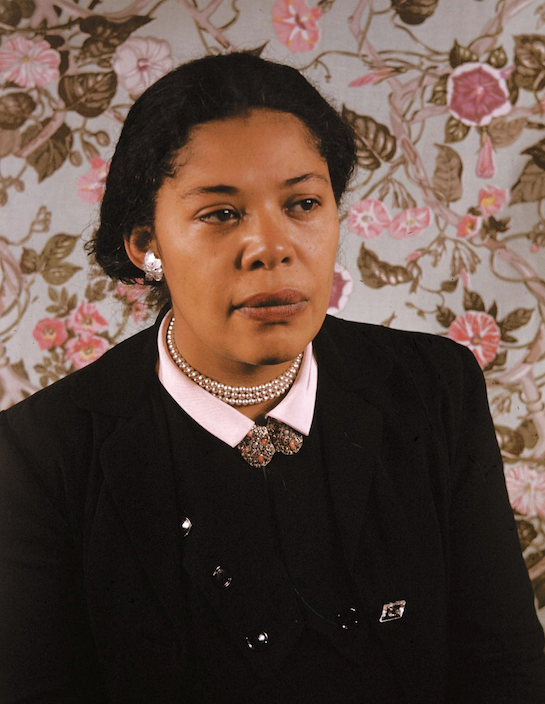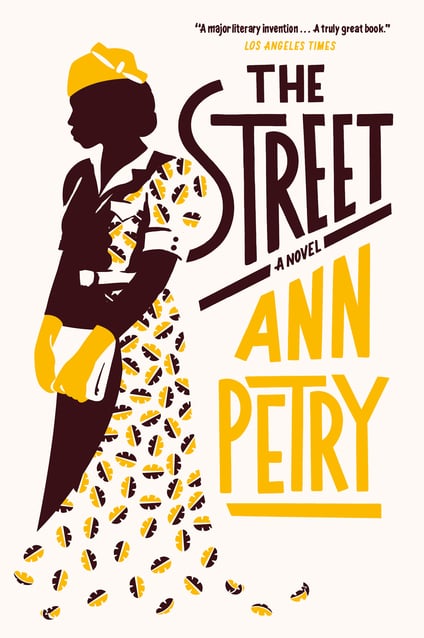The Street by Ann Petry (1946)
By Taylor Jasmine | On April 24, 2015 | Updated January 8, 2024 | Comments (1)

The Street by Ann Petry (1946) was the first novel by a Black woman writer to sell more than a million copies — all told, it sold more than 1.5 million. The story centers on Lutie Johnson, a young Black single mother coping with racism, sexual harassment, violence, and class divisions in World War II-era New York City.
Ann Petry was raised in Old Saybrook, Connecticut, and grew up as part of a middle-class black family. Her father, a pharmacist, and her mother, a podiatrist, provided a relatively sheltered life for Ann and her siblings.
Ann (who later also trained as a pharmacist) didn’t personally experience as much of the pervasive racism that permeated American life, but she was certainly aware of it, as exemplified in the story of The Street.
A literary award for a first novel
Ann followed in her father’s footsteps and became a pharmacist, but writing was her true ambition. She was an admirer of Jo March, the budding author and main character in Louisa May Alcott‘s Little Women. Moving to Harlem from the tranquility of Old Saybrook with her husband had a profound impact on her writing. Her observations inspired her to begin working on her first novel.
In 1943, she applied for the Houghton Mifflin Literary Fellowship by submitting the first few chapters of The Street, and won the award. The fellowship, which came with a handsome cash award, allowed her to finish the novel.
In Ann Petry (1996), a concise biography and analysis of the author’s literary canon, Hilary Holladay observed:
“Since Petry lived in Harlem during the 1940s and worked there for several years as a journalist, it is not surprising that her descriptions of wartime Harlem are just as detailed and realistic as her descriptions of little New England towns. Her portrayal of the urban North is generally a bleak one.
In contrast to her fictional small towns, there is no pretense of a pretty surface in Petry’s vision of Harlem. For most of her Black characters there, life boils down to the horrors of racial subjugation. In her most sustained portraits of Harlem — such as The Street and ‘In Darkness and Confusion’ — the ghetto is a sad, painful place to live.
The urban Black characters’ suffering is especially acute once they come to believe that there is no better life ahead, that the American dream of success is not theirs to strive for, let alone achieve.”
. . . . . . . . . . .
See also: Country Place by Ann Petry
. . . . . . . . . . .
Plot synopsis and characters
The Street is the story of Lutie Johnson, a single Black mother living in World War II-era Harlem with her 8-year-old son, Bub. Lutie loves the wisdom of founding father Benjamin Franklin, and believes that if she follows his principles of thrift and hard work, that she can aspire to the American dream.
Lutie aspires above all to be able to move herself and Bub away from their 116th Street tenement. She and her husband Jim are separated but not divorced, their marriage destroyed by infidelity and financial strain. Petry didn’t shy away from harsh descriptions of racism that were all too common in the north.
“Streets like the one she lived on were no accident. They were the North’s lynch mobs, she thought bitterly; the method the big cities used to keep Negroes in their place. And she began thinking of Pop unable to get a job; of Jim slowly disintegrating because he, too, couldn’t get a job, and of the subsequent wreck of their marriage; of Bub left to his own devices after school. From the time she was born, she had been hemmed into an ever-narrowing space, until now she was very nearly walled in and the wall had been built up brick by brick by eager white hands.”
The story is told through multiple points of view, though mainly taking Lutie’s perspective. She settles for a shabby walk-up apartment in Harlem, since it’s the best she can afford, and takes an immediate dislike to the building’s super, Jones.
A disillusioned Navy veteran, Jones becomes sexually obsessed with Lutie, even using Bub as a means to get closer to his mother. Complicating matters is that Jones lives with his girlfriend Min, who he resents for her lack of physical attractiveness.
Other major characters include Mrs. Hedges, the madame of a brothel who is disfigured from a fire. Sensing Jones’s interest in Lutie, she discourages him from pursuing her. Junto, who is white, is a friend of Mrs. Hedges and the proprietor of local dance halls and bars. He also wishes to possess Lutie sexually.
Min, Jones’s girlfriend, believes she can make her abusive lover a better man. And Boots Smith, a bandleader who works for Junto, also has an interest in Lutie, attempting to lure her with false promises to help her singing career.
Sexual competition, and deception intertwine to heighten the tension in the storyline. Jones, angry that he can’t have Lutie, involves her son in petty theft. Desperation, desire, and murder figure into the climax of the story, but to say more would be to reveal spoilers!
Critical reception
When it was published, The Street was an immediate success. Most reviewers were impressed.The New York Times called it “a skillfully written and forceful first novel.’’ Still, The Street was not without its detractors.
Some African-American critics, including James W. Ivey of The Crisis, objected to Petry’s one-sided portrayal of Harlem as a “seething cesspool of sluts, pimps, juvenile delinquents …” and deemed it “worthless as a picture of Harlem though interesting as a revelation of Mrs. Petry.”
Reprinted in a new edition in 1992, the L.A. Times review commented:
“Lutie Johnson is an incandescent spirit trapped in circumstances that constantly conspire to douse her potential. White women view her as a threat and men of every race appraise her as a possible conquest. Whenever she allows herself to be naive enough to forget the rules of the game— that is, that an impoverished Black woman alone is considered prey — she is violently reminded of her situation.”
Following is a brief review that was typical of the positive reception the book received when it was first published:
. . . . . . . . . . .

More about Ann Petry
Photo: Carl van Vechten
. . . . . . . . . . .
A 1946 review of The Street
From the original review in The Evening Independent, Ohio, March 1946: The Street by Ann Petry is primarily the story of a struggle. The struggle by Lutie Johnson to make a home for her eight-year-old son, Bub, to keep him off the streets, to give him the opportunity to grow up unwrapped by fear and violence and evil … with the setting in Harlem we see a slice of life hitherto unknown to most of us.
Raw, real, and vibrant, life on the street pulses on, dominated by sharply drawn characters.
Georgia-born Mrs. Hedges, whose early association with the white trash-picker, Junto, has brought them both riches; Jones, the superintendent of the apartment house who dreams of Lutie’s beauty in his basement quarters; Min, his woman who seeks the magic potions of David the Prophet to make Jones love her; Boots Smith, bandleader of the Casino with his fancy car.
All those lives intertwine with the many others who live on “The Street.” Not a beautiful story but rather a living, violent one presenting another side of life for us to think about.
. . . . . . . . . .

Quotes from The Street by Ann Petry
. . . . . . . . . . .
2019 reissue
The Street was reissued in 2019 by Virago Books (a division of Hachette UK). In the Introduction, Tayari Jones concludes:
“Like all masters of noir, Petry looks into the abyss without falling in. This is a story that is dark, but not depressing. It is disturbing, yet intriguing. How can a novel’s social criticism be so unflinching and clear, yet its plot move like a house on fire? How can characters flirt with type, while remaining singular and unforgettable? …
This novel, like real life, is rife with seeming contradictions and layered with complex truths. And like the human experience, this book is riddled with pain, yet somehow powered by hope.”
More about The Street by Ann Petry
- Wikipedia
- Reader discussion on Goodreads
- 1992 review in the L.A. Times
- Meet Lutie Johnson in a PBS video

Thank you for this insightful review! Ann Petry’s The Street has such a profound way of capturing the struggles and triumphs of its characters. I appreciate how you highlighted the themes of resilience and the harsh realities of urban life, making it a timeless read. Definitely adding this to my reading list!